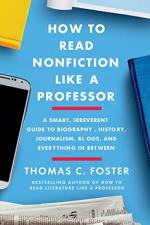
|
| Name: _________________________ | Period: ___________________ |
This quiz consists of 5 multiple choice and 5 short answer questions through Section 3: Chapter 9, "Living the News" through Chapter 12, "That Is So Last Year".
Multiple Choice Questions
1. In Chapter 7, "All in How You Look at Things," Foster uses as examples two books that have the same subject matter--Fear, and Fire and Fury. What subject matter do these books have in common?
(a) The Trump White House.
(b) Watergate.
(c) World War II.
(d) Wilderness exploration.
2. In Chapter 8, "Bringing the News," what reason does Foster give for journalists generally being proved correct despite public mistrust?
(a) Strategy.
(b) Stubbornness.
(c) Intelligence.
(d) Professionalism.
3. In Chapter 1, "The Structure of Nonfiction Information," Foster introduces the term "structural design," saying that it is similar to which term related to fiction?
(a) Narrative strategy.
(b) Storyboard.
(c) Story plan.
(d) Plot structure.
4. In Chapter 11, "Life from the Inside," Foster discusses the use of parallelism. He is discussing what technique?
(a) The use of tone that mimics the subject under discussion.
(b) The use of multiple, similar examples.
(c) The exact repetition of words and phrases.
(d) The repetition of grammatical structures.
5. What is being discussed in Chapter 10, "From the Inside Out," when Foster says that the "form and tone of the essay must fit the writer like a suit" (144)?
(a) Style and voice.
(b) Subjectivity and attachment.
(c) Conflict and theme.
(d) Characterization and personality.
Short Answer Questions
1. In Chapter 10, "From the Inside Out," what aspect of Renaissance scholarship does Foster say the essay rebels against?
2. In Chapter 2, "The Ecology of the Nonfiction Biosphere," what does Foster call the "second draft of history"?
3. In Chapter 2, "The Ecology of the Nonfiction Biosphere," Foster calls a certain kind of reader the "cognoscenti." What kind of a reader is her referring to?
4. In Chapter 5, "It May Just Be Me, But..." what does Foster say is true about quotes attributed to anonymous sources?
5. In Chapter 7, "All in How You Look at Things," Foster uses the Latin expression in media res. What does this expression mean?
|
This section contains 385 words (approx. 2 pages at 300 words per page) |

|




